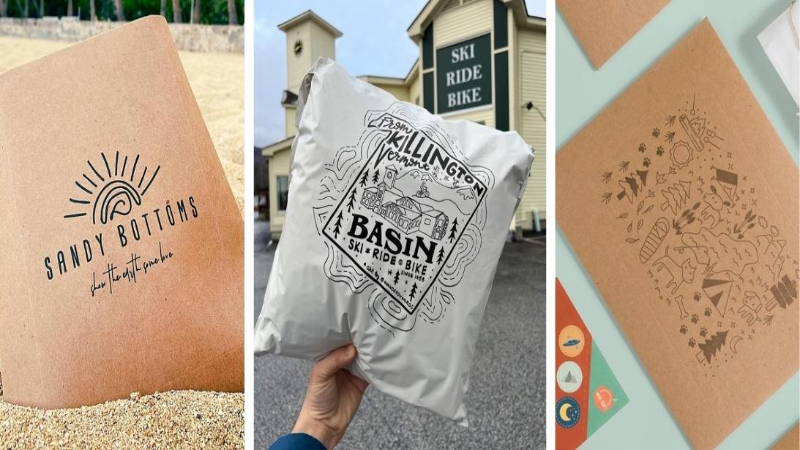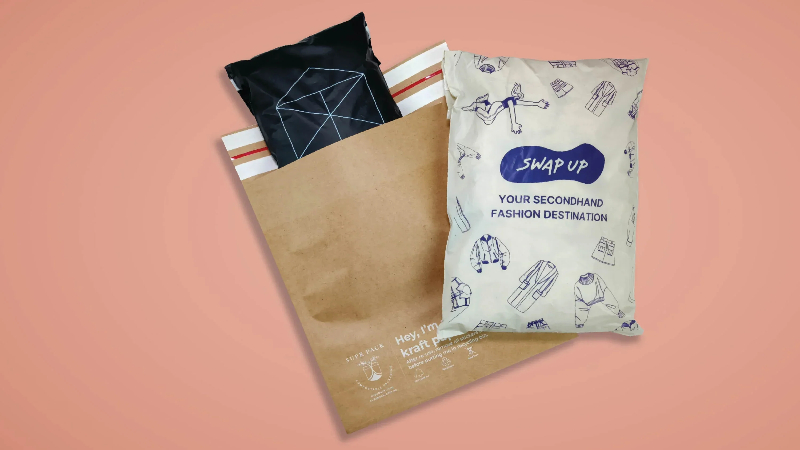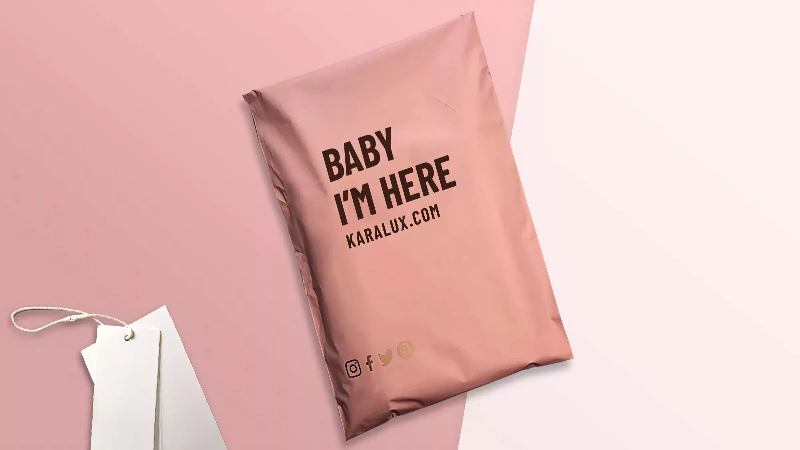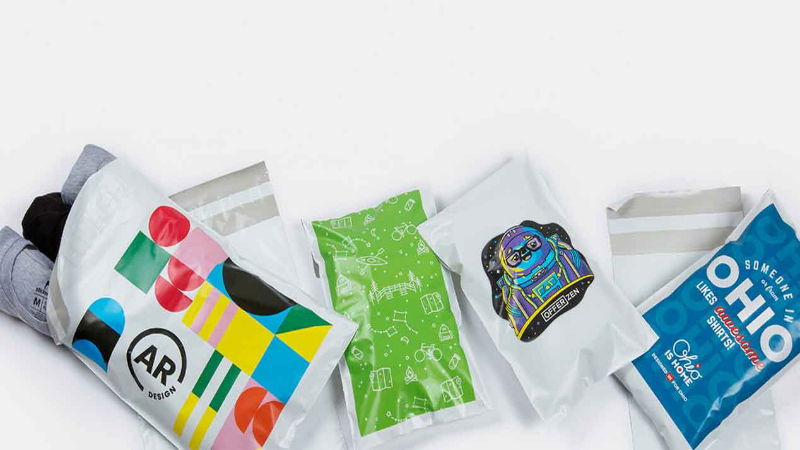Sublimate on Poly Mailers? Your Guide to Custom Packaging
In today’s fiercely competitive e-commerce landscape, your packaging is more than just a shipping container – it’s a powerful branding tool and a key element of the customer experience. This guide, “Sublimate on Poly Mailers: Your Guide to Custom Packaging,” is designed for you. Let’s read it to transform your shipping materials into powerful marketing tools!
1. Can You Sublimate on Poly Mailers?
1.1 Understanding Sublimation and Poly Mailer Materials
Sublimation printing is a unique process that transforms solid dye ink into a gas, which then penetrates and permanently bonds with polyester fibers at a high temperature. This results in vibrant, long-lasting prints that are part of the material itself rather than simply sitting on the surface.
The challenge with sublimating on poly mailers lies in the material they’re typically made from polyethylene (PE). This is a plastic that lacks the necessary molecular structure to accept and bond with the sublimated dye.
Standard PE poly mailers won’t work because the ink will simply sit on the surface, resulting in poor color saturation, easily-rubbed-off prints and a generally disappointing result. The percentage of polyester in the coating will influence the quality of the final print, with higher percentages generally yielding better results.

1.2 Choosing the Right Poly Mailers for Sublimation
Successful sublimation requires selecting the correct poly mailers. Look for poly mailers specifically marketed as “sublimation blanks” or clearly identified as having a polyester coating. These are designed for this specific purpose and will provide the best results. White or very light-colored poly mailers are essential for accurate color representation. Darker colors will absorb and distort the sublimated dye, resulting in dull and muted prints.

1.3 Step-by-Step Guide to Sublimating on Poly Mailers
To achieve professional-looking, custom-printed poly mailers through sublimation, a meticulous approach is key. Let’s break down the process into manageable steps, ensuring you get it right from the start.
- Design Excellence is Paramount: The journey begins with your design. Utilizing design software, craft your artwork with precision. Remember, the golden rule of sublimation is mirroring your design before printing. This ensures that when transferred, your image appears correctly on the poly mailer. Furthermore, the quality of your final print hinges significantly on the resolution of your design. Opt for high-resolution images to capture intricate details and vibrant colors, resulting in a crisp and impactful finish on your packaging.
- Printing with Precision: Once your design is finalized, the next crucial step is printing. Employ sublimation ink and sublimation paper to bring your digital creation to life. It’s vital to ensure your printer settings are optimized for sublimation printing to achieve the best color vibrancy and transfer quality.
- Poly Mailer Preparation – The Foundation for Success: Before you even think about heat, take a moment to prepare your poly mailer. Ensure it’s specifically coated for polyester sublimation – this is crucial for the ink to properly bind. Lay it out and smooth away any wrinkles or creases. A clean, flat surface is essential for even heat distribution and a flawless transfer.
- Heat Press Mastery – Setting the Stage for Transfer: Your heat press is the engine of this process. Preheat it to the temperature recommended for polyester sublimation. Generally, this falls within the 375-400°F range. However, remember that this is a guideline. The ideal temperature and pressure are dictated by your specific heat press model and the poly mailer’s material specifications. Always consult the manufacturer’s instructions for both your equipment and your poly mailers to pinpoint the precise settings. This attention to detail is what separates good results from exceptional ones.
- The Art of Transfer – Bringing Design to Material: Now for the exciting part – transferring your design. Position the printed sublimation paper onto the poly mailer, ensuring the printed side is facing down, making direct contact with the mailer surface. To safeguard against sticking or scorching during the heat press process, always cover the sublimation paper with a Teflon sheet. This protective layer ensures a clean and even transfer.
- Pressing Perfection – Applying Heat and Pressure: Engage your heat press, applying it to the prepared poly mailer according to the manufacturer’s guidelines. The dwell time – the duration of heat application – will vary depending on the materials and equipment you are using. Again, refer to your manufacturer’s instructions for the optimal time. Consistent pressure and accurate timing are key to a successful sublimation.
- Cooling and Revealing – The Final Transformation: Once the pressing is complete, carefully remove the poly mailer from the heat press. Resist the urge to peel off the sublimation paper immediately. Allow the poly mailer to cool down completely. This cooling period is essential for the sublimation ink to fully set and become permanent within the polyester coating. Only after it’s completely cool should you gently remove the sublimation paper to reveal your transformed, custom-printed poly mailer.
- Quality Inspection – Ensuring Excellence: The final step is a thorough inspection. Examine your sublimated poly mailer for any imperfections. Keep an eye out for common issues such as scorching, which indicates the temperature was too high or the dwell time too long. Ghosting, where the ink hasn’t fully transferred, and ink bleed-through, often caused by insufficient pressure, are also things to watch for. Identifying and understanding these potential issues will help you refine your technique for consistently perfect results.

2. Alternatives to Sublimation on Poly Mailers
2.1 Printing Methods for Poly Mailers
While sublimation offers vibrant, long-lasting prints, it’s not the only game in town for customizing poly mailers. Several other printing methods are suitable for standard polyethylene (PE) poly mailers, each with its own strengths and weaknesses:
- Screen Printing: A time-tested method ideal for high-volume orders with simple, bold designs. A stencil is used to apply ink to the poly mailer, resulting in a durable, high-impact print. Screen printing excels in producing vibrant colors on a large scale but can be less cost-effective for small runs or complex designs. It’s a relatively eco-friendly choice when using water-based inks.
- Digital Printing: Perfect for short runs and complex designs. Digital printing uses inkjet technology to print directly onto the poly mailer, allowing for full-color images and intricate details. It’s highly versatile and cost-effective for smaller orders but the print may not be as durable as screen printing.
- Flexographic Printing: A high-volume, cost-effective option for businesses needing thousands of custom poly mailers. This method uses flexible printing plates to transfer ink onto the poly mailer, ideal for repetitive designs and large-scale production. Flexographic printing delivers high-quality results at a low cost per unit but lacks the design flexibility of digital printing and may not be suitable for smaller orders.
Comparing the Methods:
| Method | Cost | Quality Design | Complexity | Volume | Eco-Friendliness |
| Screen Printing | Medium | High | Low | High | Medium to High |
| Flexographic | Low (high volume) | High | Low | Very High | Medium (depending on ink and process) |
2.2 Creative Packaging Solutions Beyond Sublimation
If sublimation isn’t feasible, there are several creative ways to customize your poly mailers and inject your brand personality into your packaging:
- Stickers: A simple, affordable way to add a personalized touch. Custom stickers can showcase your logo, brand message or a fun design element.
- Labels: Offer a more permanent solution than stickers. Explore different label materials like rubber labels, woven labels, and heat transfer labels.
- Custom Inserts: Add a personalized touch with custom inserts like branded tissue paper, thank-you notes or promotional flyers.
- Branded Tissue Paper: Elevate the unboxing experience by using tissue paper with your logo or a relevant design.

3. FAQs about Sublimate on Poly Mailers
3.1 Where can I buy poly mailers suitable for sublimation?
For high-quality sublimation-ready poly mailers, we recommend checking out Packlove. Other online retailers and packaging suppliers also offer sublimation-compatible poly mailers, but it’s crucial to carefully check product descriptions to ensure they are explicitly stated as suitable for sublimation and specify the type of coating.
3.2 What design software is recommended for creating sublimation prints?
Popular design software options for creating sublimation prints include Adobe Photoshop and Adobe Illustrator. These programs offer extensive capabilities for creating high-quality, professional-looking designs.
3.3 Is sublimation on poly mailers environmentally friendly?
It depends. Sublimation itself, while using less water than some other printing methods, still involves the production and use of inks and energy for the heat press. The poly mailers themselves contribute to plastic waste unless they are made from recycled or biodegradable materials. To lessen the environmental impact, consider using eco-friendly sublimation inks and exploring options such as biodegradable or recycled poly mailers.
Read more:
- Ship Poly Mailers USPS: Size, Weight, Cost & Best Practices
- Can You Put Poly Mailers in a Mailbox? Size and Shipping Guide
- Best poly mailers for Poshmark: Size, tips and where to buy
In conclusion, while sublimating directly onto standard poly mailers isn’t feasible, achieving beautifully customized mailer bags is entirely possible with the right approach. This guide has highlighted the importance of selecting polyester-coated poly mailers specifically designed for sublimation printing and meticulously following the heat press procedure. Let’s create packaging that leaves a lasting impression!













